
DonAndersen
-
Posts
2,212 -
Joined
-
Last visited
-
Days Won
138
Content Type
Profiles
Forums
Events
Store
Posts posted by DonAndersen
-
-
Guys,
For a couple of reasons I voted NO.
1] As far as a game fish - they don't fight as well as rainbows + they bite when you go to release them.
2] Rather than spending money trying a cross - about the 3N going to 3NAF on existing stocks.
3] And lastly, we have an Alberta Rainbow - yup a died in the wool real Alberta Rainbow - the Athabasca rainbow that will grow to 7 lbs. + given proper conditions. How about we spend some money on a local home grown product.
And lastly, there is no evidence anywhere that suggests trout will control perch. Been tried in Phillis Lake with "0" success.
catch ya'
Don
-
Anyone know of a place a guy can get one of those pontoons without ordering direct from the company in the US? The pics online look quite good.....I remember seeing them at the show a couple of years ago as well.....if you know the deal let me in on it.
Cabelas
catch ya'
Don
-
Cane
in Ask the Pros
holeshot,
Cane imported into Canada got a whole lot tougher and expensive within the past while. It now has to be fumigated when entering the US and again fumigated when entering Canada. The cost of fumigation isn't a whole lot/piece on a large order but on a couple of culms, it is expensive. I just got another 20 culms. The cost when mixed in with with a order of 200 culms stil was just short of $600 CDN.
Don't even try the cane building thing. Your better off with a drug addition and likely cheaper as well.
Here are a couple of sites.
http://www.canerod.com/rodmakers/
http://www.bamboorodmaking.com/index.html
And to put things into perspective:
http://wagnerrods.com/poobah.html
catch ya'
Don
-
A group answer:
1] We fished Patterson for 4 days
2] Of the county employees and elected officials meet, all were interest and committed to the success of the fishery.
3] I had been in the Parkland in 2004 looking over what a local committed group had accomplished. They tried hard but like here, the perch lovers followed the "quality" lake guys. Spear, East Goose and Two Mile were screwed.
4] Would I go back - you bet. I've had an opportunity to fish the lakes from BC>Manitoba. Presently, in my opinion, there is nothing to compare to the Parkland region for the quality of the angling.
5] Unlike BC, where a friend had $5,000 of gear stolen, we had no such concerns in Manitoba. Many pontoon boats tied along the lake shore. All were still there in the morning.
7] We sampled only 3 of the possible lakes. There is enough variety within the area to keep me interested for weeks/years.
8] Manitoba fishing license are cheap. Get a conversation license. You get to keep fewer fish but then who cares.
9] Some of the photos were taken by my wife who enjoyed kayaking on both Patterson and East Goose. Some of you may have seen her & Morty on Beaver now and then.
10] For a copy of the FLIPPR handbook, call the Russel or Roblin Town Offices. The handbooks are free and detail the process FLIPPR uses[d] to accomplish what they did, provide lake info, some background.
11] And watch for road signs. Missed one and 100 kph in a 80 kph zone got me a $300.00 present. I was distracted by the Casino west of Rossburne.
catch ya'
Don
-
It all started innocently enough with a couple of phone calls and emails to a friend in Red Deer. "Wanta go to the Parkland of Manitoba?" And so the plans were made, revised, made again, dates agreed on and stops thought about.
The first stop was just over the Sask. border @ a small lake SE of Lloydminister. Sufferin Lake is perhaps 200 acres located within a Provincial Park with a campground and about 60 cabins/homes along the west shoreline. We got there Monday afternoon. Camp set we got to fishing. Wasn't great with only one landed. Decent fish though about a rainbow of about 5 lbs. Caddis hatching everywhere. Steve ended with 2 brookies of 3+ lbs + a smaller 3 lbs. rainbow. The next day it all changed. The weather got cooler and cloudy with few caddis hatching. We went here and there and there with little to show for it. Finally I started to fish a leech on a floating line along the shallows. The accounted for 6 hookups and 5 landed. All about 5 lbs. +
The evening ended in rain that lasted all night and through a long drive down Highway #16 across Sask. to Russell, Manitoba. Just short of the border the rain stopped. Got more licenses and off to the campground at Patterson Lake. The campground is on top of a knoll less that 50 yards from the lake. Pit toilets, electrical service were provided @ $15.00/night.
We fished Patterson for 4 days. The first day was about learning the lake a little. With a howling NE wind, travel in a pontoon boat was tough. Still we found some fish. Good ones too!
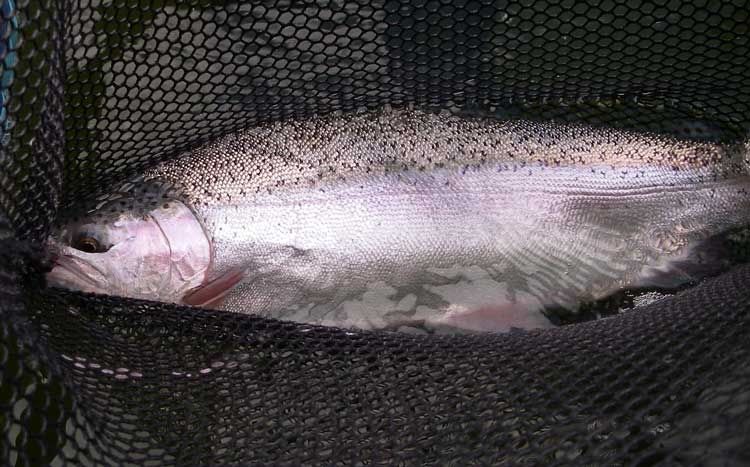
The rainbows seemed to be in greater than 5' of water and really liked chironomids. The browns, contrary to popular wisdom were found in water less that 4' deep. Adult caddis + minnows were all through the reeds. Browns seemed to lurk within feet of the reeds although we did catch a few in water six feet deep.
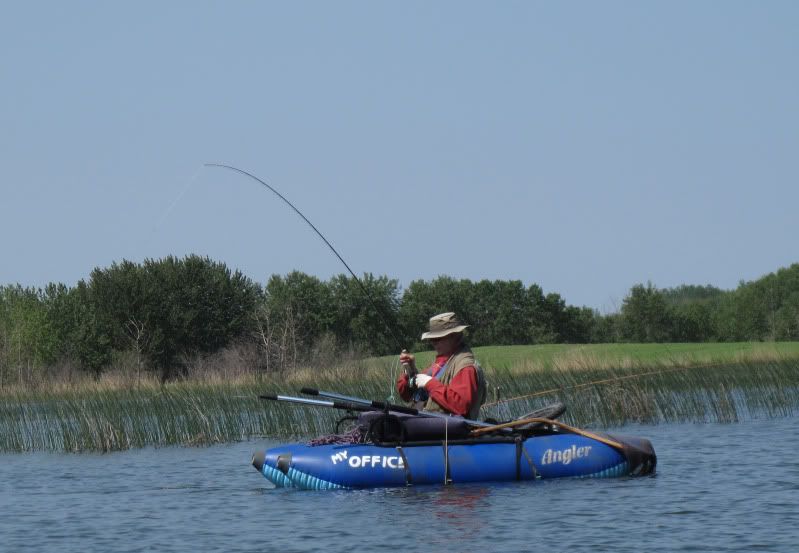
http://
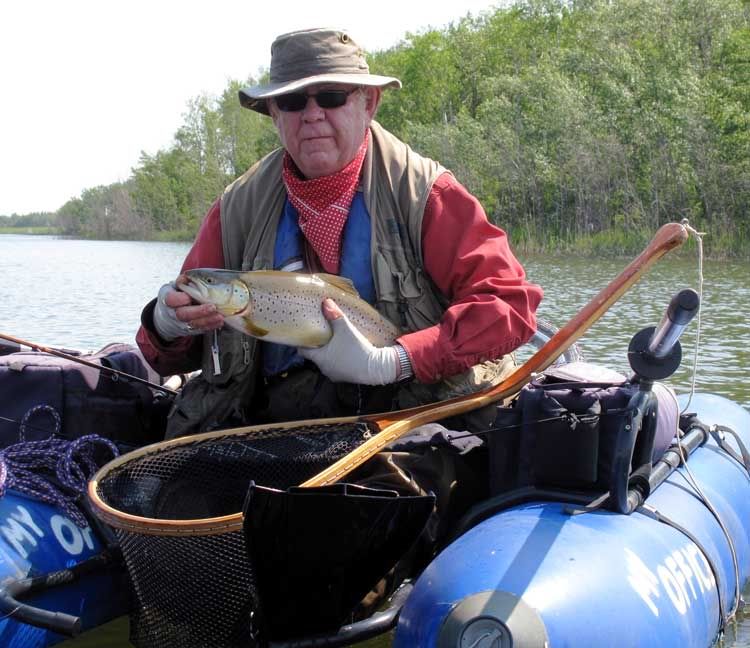
While I only caught one brown of 7 lbs. or so, Steve landed a good one measured @ 29” and estimated @ 9 lbs. We got others from 3>5 lbs.
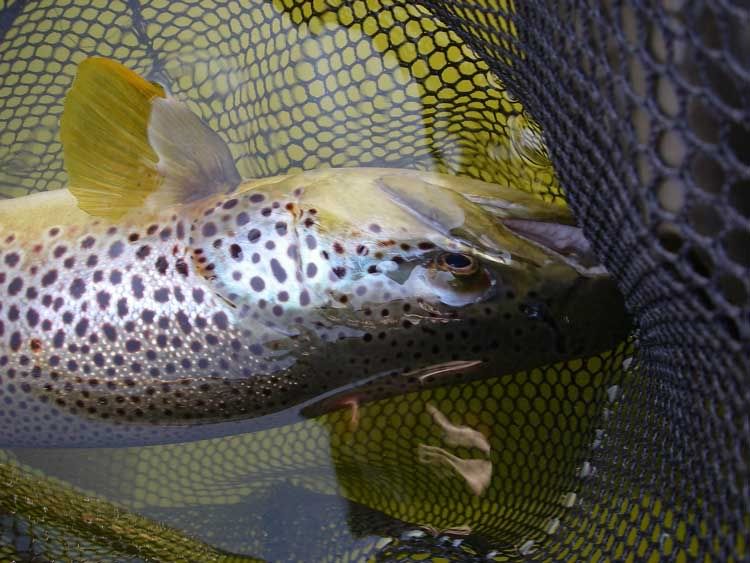
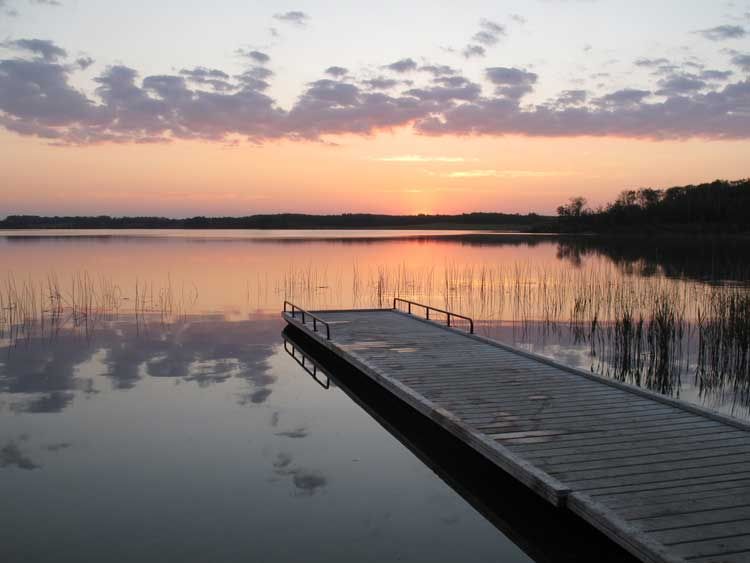
After 4 days on Patterson, we headed the 1.5 miles to Tokaryk Lake. Unlike Patterson with it's large island, Tokaryk is a shallow bowl mostly featureless. I started along the bank with a Glen's Leech under a yarn indicator. The first fish was a decent brown of maybe 5 lbs., then a good rainbow of 6 or so followed by a brown I lost and then a really good rainbow of 8 or so lbs. It was probably the largest fish I landed. Good things don't last so I headed to deeper water and a chironomid. It was a good day with 16 landed, all greater than 4 lbs. Didn't catch any browns in deep water but the rainbows were HOT. Typically runs of 30>50 yards jumping all over the place. Bright shiny rainbows.
The next day back to Tokaryk but good things rarely happen twice. It was a tough slog. Still, nine came to net including on brown of 4 lbs. Like the day before, it was deep water for me that worked. Steve, though, kept mostly to the shoreline and hooked a lot of fish breaking off perhaps 1/2 of them.
OK, after 6 days of rainbows/browns it was time to try Tigers. So off to Roblin we went to camp. Great campground right in town. For $15/night, power was provided + free showers and flush toilets. We camped about 15 yards off East Goose Lake. A concession booth/campground office provided a source of great ice cream cones. With a weather forecast for severe storms over the next 2 days, we tie flies & toured the town.
Finally, the weather cleared a little and we headed for Twin Lakes and Tiger Trout. I wish that the fishing was HOT like @ Patterson and Tokaryk but it wasn't to be. A slime line c/w a olive bugger got me one followed by 3 on deep water chironomids near the end of day. The next day arrived clear and calm. Unlike the experiments of the day before, I stayed with deep water chironomids and landed another 9. Steve tried here and there picking up a few. The fish were of decent size with 2 of them over 5 lbs.
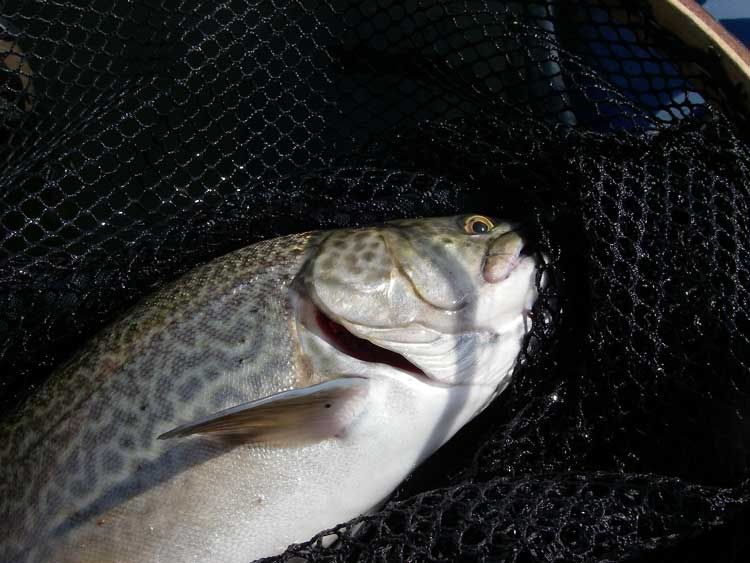
The Parkland region has some serious wildlife.
Pelicans at Patterson harvest minnows in the shallows most of the day.
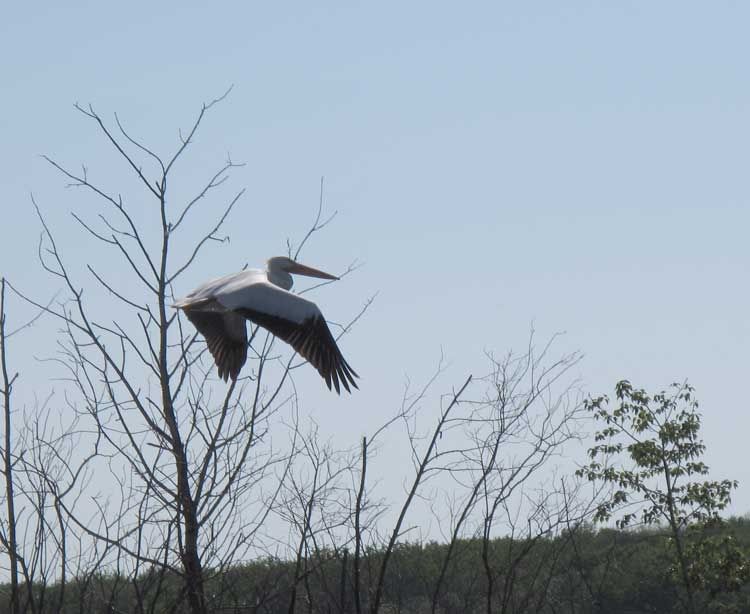
And on Toaryk, a first for me on a lake - a garter snake out for a swim 50 yards or so off shore.
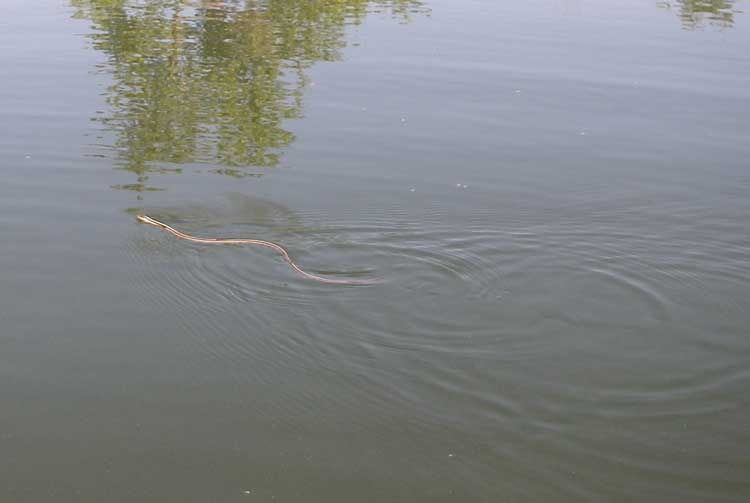
And of course, my wife's best friend and navigator. Morty the Mutt.
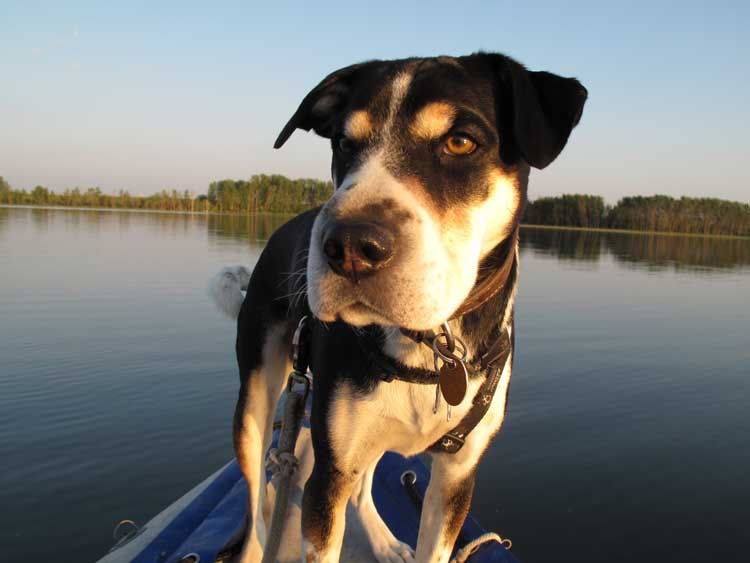
Some general observations.
* most anglers we saw fished sinking lines and leech type of flies.
* I pumped a number of fish and didn't find a single leech
* the fish had chironomids, boatman and scuds in them
* the areas visited and fished have some of the kindest and open people we've meet in many years. They are happy to see you.
* don't move to Roblin. I've never seen a town with lawns/gardens/streets so well kept. Sure would take a lot of time away from fishing.
* there was no evidence of the bank fishermen seem in Alberta. Litter on the lake shore was "0".
* most anglers encountered were from Utah followed by N. Dakota. Few folks from Manitoba in evidence.
* Pontoon boats were the boat of choice although most were equipped with electric motors so that the owners could back troll and cast.
* We only encountered 2 other chironomid fishermen.
* Take the gear you need, there seems to be no local fly shops.
* if the Parkland fishery is near the the best for rainbows/browns that I've seen.
* the water is by in large tannic in color.
* bloom started in Torayk Lake a little - trips prior to mid-June may be best
For more information on the FLIPPR organization who, along with the counties involved who operate the quality lake program see: http://www.flippr.ca/mainpage.htm
And to sum up the trip, we stopped @ Boekle's Pond west of Hanna, Alberta for the last night. Boekle's Pond is a joint ACA/SRD managed lake. Guess what - there's no fish. According to a local, a ice-fisherman drove his truck into one of the aeration holes. There goes the aeration, There goes the fish. The Pond had 6 lb. trout in it the 2 years ago. Hip - Hip Hurray for the Home team. You really shine in how to manage a fishery.
catch ya'
Don
-
ConocoPhillips Canada First to Donate Water
Water Conservation Trust of Canada Welcomes Historic Application
CALGARY, June 9 /CNW/ - The Water Conservation Trust of Canada (Water Trust) announced today it has been named a recipient in a landmark application to transfer an Alberta water licence. ConocoPhillips Canada is applying to donate the first licence to privately protect instream flow. The Water Trust protects and enhances aquatic ecosystems by accepting donations of water made surplus from licence holders.
"We are pleased to accept this valuable contribution to Alberta's instream flows," said Water Trust's executive director Maureen Bell. "ConocoPhillips Canada has been a supporter of the Water Conservation Trust of Canada from our early days, and has demonstrated its commitment to conserving water resources with this generous donation."
ConocoPhillips Canada is contributing 50 percent of its water licence on the Medicine River, a tributary of the Red Deer River. The water is available because of ConocoPhillips' conservation efforts. The Water Trust has the support of the Red Deer River Watershed Alliance to hold the water in this tributary.
"We believe this is an important opportunity to contribute to the sustainability of the Medicine River," said Lloyd Visser, ConocoPhillips Canada Vice President, Environment and Sustainable Development. "Our application aims to support the habitat enhancement and recreation values of this river."
ConocoPhillips Canada has earned a 2010 Emerald Award nomination for water management initiatives including this donation. The Emerald Awards celebrate the achievements by individuals and organizations in Alberta committed to protecting the environment. The winners will be announced Thursday, June 10 in Calgary.
The Water Conservation Trust was founded in 2006 with the objective of participating in Alberta's water market to the benefit of aquatic ecosystems. "Water is our most precious resource and the demand for it continues to grow," said Bell. "This is particularly true here in semi-arid, southern Alberta where rivers are over-allocated."
In 1999, the Alberta government introduced the Water Act, which created the framework for the water market and paved the way for organizations such as the Water Trust. The Water Trust has been working to co-ordinate its efforts with both the provincial and federal governments to achieve objectives consistent with their conservation policies.
Alberta Environment is reviewing ConocoPhillips Canada's application. A decision is pending.
Water Conservation Trust of Canada
The Water Conservation Trust of Canada was established as an effective water market management tool. Its mission is to improve social, economic and environmental outcomes by acquiring water entitlements for instream flow. The current activities of the Trust are focused in the water market in Southern Alberta.
-
Guys,
Is there still a maximum length of packages sent to Canada? If I recall correctly, it was 43".
Don
-
McLeod,
Couldn't agree with you more on the ACA - they lost their focus if they ever had one. They spend more money from the Grant Eligible fund on moths than fish habitat. No kidding/no BS
But mostly the resolution to most of Alberta's fisheries issues is political. Even when the budget surpluses were huge, SRD got low balled.
Don
-
frypan.
I am the problem. I, and people like me, allowed this province's government to short change fisheries/habitat/environment + social issues all over the place.
And I'm ashamed of myself. But the real question is "how do we dig this place outta the crapper"?
Don
-
PeteZahut,
It would appear that you figure that the folks that arrived within the past few years bother me. Nope you got that wrong.
What new folks don't see is what is gone. They see what is there today and cannot appreciate what was lost. Their experience starts upon exposure.
What they don't see/experience likely will never motivate them to do something/anything about the issues. That does beg the question. The real question is can the clock be turned back.
Sure it can. All it takes is for folks to realize what was here before and work at the restoration. In the copied article are a number of examples of people working hard @ turning back the clock restoring fish populations and habitat.
How that is to be done is a tough one.
Perhaps ownership motivates the driving force effecting change.
What reflects ownership? There you got me. But I often wonder about the owners of quads ripping up the landscape if they feel that they have ownership in the land.
Here is but a partial list of what was lost:
1] Castle River/Crownsest River/Oldman River under the Three Rivers Dam
2] Waterton River under a dam
3] Red Deer River under a dam
4] Kananaskis River under a dam
5] Water diversions destroying fish - St. Mary's, Bow, Waterton, Oldman
6] Reduction in fishing opportunities through decreased stocking of marginal trout streams - Buster, Cow, Mud Creeks + a host of other
7] Closing of access points along streams - many provinces and states work hard @ keeping them open - Montana for one
8] Decreased SRD fisheries budgets - a political attack.
9] Lets not forget the complete and utter destruction of streams in the Oil Sands area.
10] and on and on
See PZ - no new folks listed there anywhere.
Don
-
frypan,
As the article points out - people who have no knowledge of what existed before never concern them themselves with what is gone.
Many of you likely never fished and never will the mileage that is under the the Three River Damn. The Crow that was buried was some of the best water. The Oldman north of Cowley was where I caught my first stream brown. It's gone. On the Horseshoe Bend there was often 4>10 vehicles. Ever see any there now?
Do I miss it - you bet but if you never experienced the river, why would you care.
So much of Alberta's waters have been altered or lost due to many reasons. Nearly 30% of Alberta's population arrived within the past 10 years. They have no knowledge is what was once the norm. They start @ what they see and experience now. The history and loss they never experienced.
If you arrived in southern Alberta today, the norm is now crowds of random campers riding their quads up and down the Oldman tributaries. Is this the "new" normal. God I hope not.
regards,
Don
-
frypan,
I was stuck on how to describe those folks that have no history in Alberta. "New" people seemed the least offensive - immigrants, transients, guest workers et al all seemed to have connotations that would offend many.
Don
-
Ladystrange,
Seriously - what are the "rules" for teaching FF to women.
I have been wanting and did try to get a women only course started in Rocky. Not enough interest but I'll keep trying.
FF is a head not physical game. Women are able to do as well as men - probably better from my experience.
regards,
Don
-
Folks,
I've thought about this a lot and there are certainly reasons why fish stocks decrease. In Alberta with the influx of "new" people who neither know or care of what was here once, the fish stocks can and will decrease unabated. Tis a sad commentary on our world.
The below was sent to me my a retired SRD Biologist.
The article expresses what I've seen.
catch ya'
Don
The Natural World Vanishes:
How Species Cease To Matter
Once, on both sides of the Atlantic, fish such as salmon, eels, and, shad were abundant and played an important role in society, feeding millions and providing a livelihood for tens of thousands. But as these fish have steadily dwindled, humans have lost sight of their significance, with each generation accepting a diminished environment as the new norm.
by john waldman
If you are a resident of the East Coast of the United States or of Western Europe, when did you last attend a shad bake, eat an eel, or watch Atlantic salmon vault a waterfall? Community shad bakes once celebrated the return of American shad to rivers as a marker of spring. Recently though, a dearth of shad led to a “shadless shad bake” on the Hudson — a river that in its glory days supplied more than four million pounds of shad in one season. Eels were widely consumed by Europeans and Americans in the 1800s and were often featured on holiday tables. And salmon once ran inland in countless numbers, providing sport and food; today, only a few hundred wild salmon remain in the eastern U.S., migrating up a handful of rivers in Maine to spawn.
Today, most people in the U.S. and Europe are scarcely aware that eels, wild Atlantic salmon, shad, and alewives — once-vital sources of food and employment — are no longer a part of their ordinary experience. This decline in importance is a manifestation of a loss of standing in society for these fishes, part of a larger phenomenon involving a regrettable interplay between ecology and the social order.
Every generation takes the natural environment it encounters during childhood as the norm against which it measures environmental decline later in life. With each ensuing generation, environmental degradation generally increases, but each generation takes that degraded condition as the new normal. Scientists call this phenomenon “shifting baselines” or “inter-generational amnesia,” and it is part of a larger and more nebulous reality — the insidious ebbing of the ecological and social relevancy of declining and disappearing species.
My colleague, Karin E. Limburg, and I have come up with another term for the broader context of this phenomenon: “eco-social anomie.” Anomie is defined as a state or condition of individuals or society characterized by a breakdown of social priorities and values. Eco-social anomie describes a biological and cultural feedback loop that spirals toward this breakdown: As species disappear, they lose both relevance to a society and the constituency to champion their revival, further hastening their decline. A vivid example of this was highlighted in a recent study in Conservation Biology, in which researchers found that younger residents along China’s Yangtze River knew little or nothing of the river dolphin, the bajii — now believed to be extinct — and the threatened paddlefish.
“Our data from the Yangtze shows that, in certain cultural environments at least, local communities will immediately start to forget about the existence of even large, charismatic species as soon as these species stop being encountered on a fairly regular basis,” said Samuel Turvey, lead author of the study.
In the case of migratory fish, their once-vital niche in society is often reduced to vestigial place names, such as the Sturgeon Pool in the Hudson watershed in New York and the Salmon Kill on the Housatonic in Connecticut, which today offer local color — but no eponymous fish. Numerous measures show that the two-dozen migratory fishes of both shores of the North Atlantic have seen profound reduction. An historical review that I conducted with Limburg, of the State University of New York — College of Environmental Science and Forestry, on the sturgeons, salmon, shads, eels and other fishes that migrate between fresh and salt waters revealed deeply alarming statistics. Of 35 studies of the long-term fate of migratory fish, relative abundances had dropped below 98 percent from historic highs for 13 species, and below 90 percent for another 11, with most species reaching their lowest levels in recent years.
Numerous populations of these fishes persist at sharply reduced levels, but all species had suffered local extirpations and many are now classified as threatened or endangered. A particularly worrisome case is the European sea sturgeon, so highly regarded that in the 1300s it was designated as a “royal fish” by England’s King Edward II. Sea sturgeon once comprised almost 20 populations in rivers between the Baltic Sea and the Black Sea; they are now restricted to a vanishingly small stock in France’s Gironde River..
Even such lightly fished species as alewife are now protected from any harvest in several U.S. states because of recent population crashes. Habitat loss (especially damming), overfishing, pollution, and, increasingly, climate change have all contributed to declines in this group. Warming is already altering the geographic ranges and timing of migrations of some fishes, which likely will create “mismatches” to their established ecological relationships.
Because of their remarkably high abundances and importance in early Colonial times and the sheer magnitude of their subsequent collapse, North Atlantic diadromous fishes — those that migrate between salt and fresh water — offer a particularly egregious example of eco-social anomie. Here is a generalized history: As industrialization intensified, already overharvested migratory fish populations were sacrificed for the construction of dams for power mills. This blockage of spawning habitat reduced runs further, wiping out upriver fisheries and causing downriver fisheries to dwindle or perish. The fundamental aquatic ecology of these systems also was harmed: With fewer adults entering rivers and fewer juveniles leaving them, the normal energy transfers between fresh and marine waters were reduced, and interdependencies between diadromous fishes and their associated animal and plant communities withered.
With catches diminished, local dependencies on this food source declined, and with that, a primary constituency for the welfare of the fish runs. Industrialization led to increased contamination, growing human populations led to greater discharge of sewerage, and rivers began to serve more as power sources and gutters for societal wastes than as productive ecosystems. The disappearing migratory fishes may have granted “permission” for additional ecosystem corruption because there was less cost in further debilitating rivers.
Mitigation for the loss of wild runs of these fishes was most often in the form of the easy but nearly always ineffective — if not downright destructive — stocking of hatchery-reared specimens. The exquisitely fine-tuned life histories of natural runs to their home rivers became quashed by mass-produced specimens that were less fit, but that nonetheless competed with any remaining wild individuals, reducing their fitness, too, as they interbred. Responsibility for the continuity of the runs shifted away from maintaining ecological integrity of fish runs and rivers to what amounted to a cosmetic patch via outsourcing. Abundant research has shown that a fish is not a fish is not a fish.
As Richard Judd wrote in Common Lands, Common People, “An artificial resource maintained in a habitat no longer capable of spontaneous growth, fish became a property of the state rather than an element of the providential natural landscape.”
To put an end to the steady degradation of many ecosystems — marine and otherwise — we need to rewind important historical connections and dependencies. But tools to do so are also necessary: funding, legislation and, finally, education to rebuild societal awareness and the will to effect needed changes.
In the U.S., until the importance and legal standing of these fishes and their habitats were elevated with the Clean Water Act of 1972 and other environmental statutes, resource managers lacked the means to do much except to try and maintain existing baselines. Since then, a few victories have been won and critical precedents set. It took a population crash of Chesapeake Bay striped bass in the 1980s to push Congress into enacting laws that forced the necessary draconian changes to those fisheries. But these fish made a celebrated comeback, showing what can be accomplished with a truly determined effort. The striped bass was fortunate because it had a vocal constituency of commercial and recreational fishermen calling for its revival.
The lesson from this — one which has been learned the hard way across all kinds of fisheries — is to avoid reaching the crisis stage. This philosophy, known as the “precautionary principle,” is beginning to take hold with the simple wisdom of erring conservatively in setting fish harvests.
Maine has shown exemplary leadership in reopening rivers to migratory fishes with the dismantling of the Edwards Dam on the Kennebec River in 1999, an action that allowed sturgeons, shad, and striped bass to swim and spawn in a 17-mile stretch of the river that was blocked for a century. Similar efforts are underway in Maine’s Penobscot River, and these include novel compromises that will maintain hydroelectric power generation levels while eventually reopening hundreds of miles of main-stem river and tributaries.
Many smaller dam-removal and fish-passage efforts are also underway on both sides of the Atlantic, including efforts to bring Atlantic salmon back to the Thames, the Rhine, and the Seine. Maine also is home to the newly formed Diadromous Species Restoration Research Network that will help coordinate restoration efforts of academic, government, and watershed activists and residents, both in the Penobscot River and throughout the northeast.
Alewives were once so numerous along the eastern coast of the U.S. that they were likened to the passenger pigeons of the sea. Sadly, precipitous decline across much of their range is reminiscent of the passenger pigeon’s demise. A new amendment to the Atlantic States Marine Fisheries Commission’s Interstate Management Plan for alewife and its relatives calls for detailed restoration, adapted to the state level.
MORE FROM YALE e360
With Temperatures Rising,
Here Comes ‘Global Weirding’
They’re calling it “global weirding” — the way in which rising temperatures are causing species to change their ranges, the timing of their migrations, and the way they interact with other living things. And the implications of all this are only beginning to be understood.
READ MORE
Many grassroots organizations also are fighting for protection and restoration of their alewife spawning creeks on a local level. Reconnecting the public with their neighborhood alewife run has been brought to an advanced plane in the Ipswich River, Massachusetts, with an innovative Adopt-a-Herring Program, where students track radio-tagged individuals as they migrate upriver, learning much about fish and stream biology along the way, as well as regaining a sense of responsibility for securing continuity for this natural phenomenon.
Although we are still far from hearing the societal shout on their behalf that is needed, voices are rising as numbers of many North Atlantic diadromous fishes continue to dwindle. But it will require greater concerted action to actually reverse their vicious spiral. Until then, these creatures would be advised to heed the words of Henry David Thoreau, from A Week on the Concord and Merrimack Rivers: “Keep a stiff fin then, and stem all the tides thou mayst meet.”
-
scott,
The belly boat has hung on a nail in my unheated garage for 35+ years, the pontoon boats for about 15 - so far - no issues.
catch ya'
Don
-
Colin/James,
There is booby flies and booby fishing.
The booby was originally tied to operate in much the same way as garlic marshmallows or Powerbait where the fly hovers off the bottom a foot or so. The line used was a type 4 or greater. It was cast out and the line was allowed to settle completely to the bottom. The booby was not retrieved @ all. The angler tucked his rod under his arm and waited. It was deadly as all get out and for that reason was banned from most English Stillwaters as unsporting. Just for the "unsporting" comment, I had to try it. Works but it is ugly.
If you decide to fish it in the non-traditional way - go for it. The traditional presentation is tough on trout.
A roly poly cast was named by the Brits. It is accomplished by tossing your line as far as possible, waiting for it to sink to your desired depth, tuck the rod under your arm and retrieve with both hands - fast. Fish react - particularly fresh stockers or very aggressive fish working minnows.
catch ya'
Don
-
A 6'0" 2 wt. bamboo.
Don
-
Bobbies - the down side. While we all like 'em, well most of us anyway, there is a downside to bobbies.
They are not terribly fish friendly.
I have used them - rarely do any more. The fish tend to take them deep - like @ the entrance to the stomach making release & survival of the fish a real issue.
While there are "traditional " bobbies there are a host of flies that can be tied to float, I've tied and used leeches & dragons. In every case, the fish ate the bobbies deep.
If you intend to eat the fish, use bobbies - otherwise....
catch ya'
Don
-
Folks,
In an interview today, a spokesperson for Banff national Park told the interviewer that booze will be banned from all public campgrounds in the park over the May long weekend. Persons who show up will be either turned away or they can dump the booze.
But, I'm not really pleased!!! Now the rowdies show up where I live but again they will be in for a surprise. Apparently 90 officers including SRD, RCMP + others will be attempting to keep the lid on.
As a side note, watched a lot of decent liquor hit the ground last year.
catch ya'
Don
-
Guys,
My tackle box is what holds the tools/vice/glue/thread etc. Then there are 3 tubs + of course the tying lamp. Trying to cut down. Got a new trailer on order. Need to cut down so that there is room in the new trailer for both wife and dog.
Saw a decent case years ago that Darren Atkin had @ the FF conclave in Calgary. Should have asked him where he got it.
regards,
Don
-
Folks,
I travel when fishing and always take along a selection of tying equipment and materials. At this point, there are 3 tubs and a tackle box full of "stuff". Do you guys know if anyone who makes a larger typing bag. Looked @ the Fish Pond Tying Bag. and it needs a much larger brother.
regards,
Don
-
Guys,
I've caught browns 24" long that might have weighted 5 lbs. barely [flowing water]. A friend has a brown on the wall that was 24" - weighted 10 lbs. 14 ozs. [ beaver dam]
Weight depends on genetics, water quality & flow rate.
catch ya'
Don
-
Smitty,
Nope - no notable quotes from Glen Beck there. Amazing the amount of money he gets from feeding Paranoia, Racism & Stupidity. Reportedly over $20 million/yr. I'm in the wrong line of work.
Don
-
Bloom,
So you ran into the road runners. Have seem them everywhere. Amazing what greed will do!
catch ya'
Don


Should We Stock Tiger Trout In Alberta?
in General Chat - Fishing Related
Posted
Sundancefisher,
I never suggested displacing rainbows and you didn't. Now how about you/others find another lake/body of water that could be turned into a new fishery, solicit the help to make it happen, raise the funds and do the work.
I know that there are at least some fishermen who would like to fish for an Alberta Trout. I'd rather the $'s were spent on them. Wouldn't it be neat to catch a real Alberta Trout. Sure we have bulls [which is at least a part Alberta Trout] and they fight like tigers. Whoopee!!
The tigers I fished for weren't all that aggressive. Took a #16 chironomid and hours to catch the ones I did. Landed 13 of the things between 3>5 lbs. They fight like walleye. You know walleye. Like towing a gunny sack around. Of course the larger ones fight better. Like towing a gunny sack with a rock in it.
And ya', I tried the typical lake fishing thing of sinking lines and various buggers. The bugger fishermen were catching 2>4/day - mind you, they were trolling. From their demonstrated lack of success, I went to a chironomid.
catch ya'
Don